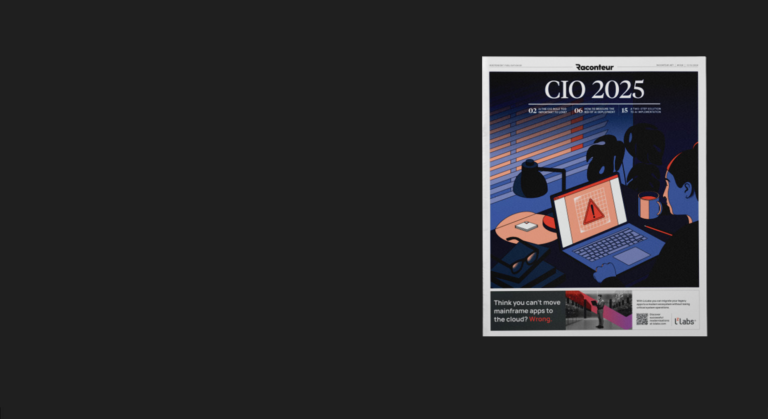A transformation study by Boston Consulting Group found that five times as many companies focusing on culture perform well financially compared with those that neglect culture (90% v 17%). That’s the carrot, or the incentive to act — and the stick is just as persuasive and more familiar: according to the Project Management Institute, at least one in six IT projects goes so badly wrong that it threatens the very existence of the company.
Mainframe modernisation finds itself slap bang in the middle of this current business dilemma. Modernizing legacy applications is a crucial enabler of the change agenda — upwards of 70% of corporations in Europe and the US are embarking on the migration journey, according to LzLabs’ own research. Given the scale of the technical challenge, the danger of focusing solely on the technology aspect of the project and neglecting culture is very real.
At LzLabs, where we’ve recently transformed from a product provider to a solutions company, we have some big lessons we’d like to share about how to prime your people for change. Our first observation may seem pretty obvious — but it’s worth restating: the time for change is now, and the risk of doing nothing is significant.
Our next, equally important share is that each change journey, especially a mainframe modernisation path, is unique – there’s no silver bullet. Successful change always takes the form of a curve, first going down and then upwards again. You want to reach the uplift at the end, and not stay stuck on the slippery, downward slope.
This is related to the earlier mentioned dual risk of technical capability and employee resistance. As our former client Swisscom confirmed, most companies embarking on the mainframe modernisation journey focus on the technical challenges because they are more easily discovered and quantified. These technical challenges are very real, and they can be tackled and resolved with or by a competent partner that will help you assess the impact, stick to your vision and be disciplined about decision-making. At LzLabs we’ve encountered this regularly and are accustomed to dealing with it.
However, our biggest learning from our own transformation journey, is that during significant change, culture is paramount. Understanding and nurturing the value of human capital and to be able to bring our people with you, is key.
Why? Every issue you encounter during a transformation will be managed according to how your people deal with it as individuals. And every employee confronted with change will go through different stages of shock, accompanied by fear or perhaps anger, which raises cortisol levels. Having a healthy amount of stress — or cortisol — is good as it provides the energy to engage effectively with fresh challenges. But raised cortisol can also fuel sour or toxic emotions, or be followed by a crash and depleted energy levels.
So how to crack the cultural code? How to avoid a negative culture is eating your transformation strategy for breakfast?
Well, one must understand the mindset of the people who will need to go through the change and tap into that, and motivate them towards a positive contribution.
How can we be so sure about that? Because also we at LzLabs have transformed and are still going through processes of change.
Here are our lessons about cultural adaptation learned along LzLabs’ transformation journey:
- Having a senior leader (preferably close to the part of the organisation undergoing the change) in place who endorses and sponsors the change is non-negotiable. Find a courageous, respected sponsor who is convinced that the journey (for example modernization) is a worthwhile project, and who dares to embark on the project under the full acceptance that challenges will arise, and that they will be overcome as a team. Inspired tech leadership is needed to make the argument and bring the team on board, all the way through Go Live.
- Using senior leaders to showcase the desired new skills and behaviours is highly effective. As LzLabs’ business offers more solutions, our projects become more complex with multiple and demanding customer interactions. We ensured our Head of Delivery was showcasing the active listening skills that are so important when communicating with clients. This way we supported our delivery team in building and balancing the two skill sets: deep technical problem-solving and client-facing capability.
- Asking questions is a crucial tool to flush out hidden complexities and to tap into the common wisdom of your team. Engage them in finding solutions and give them a say in certain decisions, for example on go-live criteria. In this way you give people a sense of control and a say in the future they will be part of. As LzLabs changed into a matrix organisation, we created a task force that included employee representatives who decided on new reporting lines and structures of the team, and styles of working. What has worked well for us in the past is using an external coach to ask the right questions to the team and also bring hidden fears and anxieties to the surface. This stops the danger of hurt and pain becoming toxic and tainting and incapacitating the culture.
- Finally, building bridges between people working in the old and new environment realises the full benefits of change for individuals. Ensuring that knowledge transfer goes in both directions (for example between mainframe and PostgreSQL folk), enriches everyone and gives each tech person a stake in the transformation. As Go Live approaches, people need to feel at home and know their role in the new environment, to be comfortable as well as competent in Linux or the cloud.
In summary, mainframe modernisers have taken the first courageous step – they know they have to change in order to secure their future. But they will need to transform their organisational culture too, and that calls for sponsorship of senior technology leaders, modelling new behaviours and skills, and actively listening and involving staff and customers early on. From my experience, as legacy modernisation is essential to sustain the company’s growth, technology leaders are receiving support from other business functions. Understanding that success of change depends on how people deal with it and that every step on that journey is essential, workable and beneficial will be the critical job of every senior leader. And remembering the words of eminent scientist Charles Darwin will surely keep them on track.



